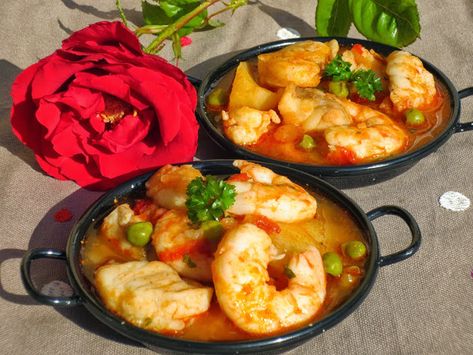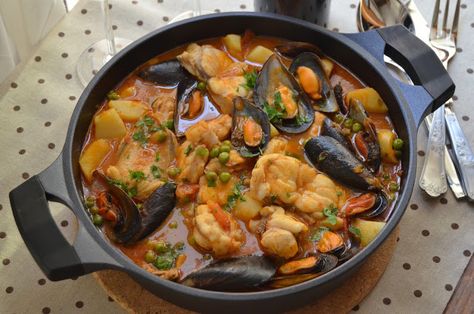There’s something magical about a dish that transcends time and culture, bringing people together over shared meals. Imagine sitting at a table with family or friends, savoring a hearty stew bursting with vibrant flavors—each bite transporting you to Spain’s sun-drenched coasts. That’s exactly what happens when you dive into Caldereta of Rape , a traditional Spanish seafood stew made with monkfish, tomatoes, peppers, and aromatic spices. Beyond its deliciousness, this dish tells a story of heritage, tradition, and the simple joys of cooking with fresh ingredients. By the end of this article, you’ll not only understand the origins of Caldereta of Rape but also have all the tools you need to recreate it in your own kitchen. So grab your apron, because we’re about to embark on a culinary adventure!
What is Caldereta of Rape? Understanding the Dish
Before diving into recipes and techniques, let’s take a moment to unpack what makes Caldereta of Rape so special. At its core, this dish is a celebration of simplicity and flavor. It combines humble ingredients like monkfish (known as “rape” in Spanish), ripe tomatoes, bell peppers, garlic, and spices to create a rich, comforting stew. But don’t be fooled by its straightforward nature—it’s packed with layers of taste that reflect centuries of culinary tradition.
The Origins of Caldereta of Rape
To truly appreciate Caldereta of Rape, you need to know where it comes from. This dish hails from Spain, a country renowned for its love of seafood and bold flavors. Historically, coastal communities relied on local fish and produce to craft hearty meals that could sustain them through long days of work. Monkfish became a favorite ingredient due to its firm texture and mild flavor, making it ideal for stews. Over time, Caldereta evolved into a staple dish during festivals and family gatherings, symbolizing warmth, togetherness, and abundance.
If you’re searching for authentic Spanish cuisine, Caldereta of Rape should definitely be on your radar. Its history ties it closely to the Mediterranean way of life, where food isn’t just sustenance—it’s an experience meant to be savored.

Key Ingredients That Make Caldereta Special
The magic of Caldereta lies in its carefully chosen ingredients. Here’s a breakdown of what goes into creating this iconic dish:
Each component plays a crucial role in building the dish’s unique profile. For instance, tomatoes provide a tangy base, while paprika adds a smoky undertone. And of course, monkfish brings everything together with its delicate yet satisfying texture. When shopping for these items, prioritize freshness—your taste buds will thank you.
The Unique Taste Profile of Caldereta of Rape
So, how does Caldereta of Rape actually taste? Picture this: a medley of savory, slightly spicy, and aromatic notes dancing across your palate. The sautéed garlic and onions form the foundation, filling your kitchen with irresistible aromas. As the stew simmers, the flavors meld beautifully, resulting in a harmonious blend that’s both comforting and exciting. Whether you’re a seasoned chef or a beginner cook, preparing this dish feels like creating art with food.
How to Prepare Caldereta of Rape – A Step-by-Step Guide
Now comes the fun part: learning how to make Caldereta of Rape yourself! Follow along as we walk you through every step, ensuring success even if you’re new to Spanish cooking.
Preparing Your Ingredients
Start by gathering and prepping everything you’ll need. Organization is key here; having your ingredients ready ensures a smooth cooking process. Here’s a quick checklist:
- Clean and cut the monkfish into bite-sized pieces. Pat them dry with paper towels to prevent excess moisture from diluting the sauce later.
- Dice the tomatoes, bell peppers, and onions into small, uniform chunks.
- Mince the garlic finely—it releases more flavor when cooked.
Pro tip: Keep a bowl nearby to collect scraps, making cleanup easier afterward.
Cooking Instructions
Once your prep work is complete, it’s time to get cooking. Divide the process into four distinct phases for clarity:
Phase 1: Sautéing the Aromatics
Heat olive oil in a large pot over medium heat. Add minced garlic and diced onions, stirring frequently until they turn golden brown. This step builds the flavor base for your stew.
Phase 2: Building the Sauce
Next, toss in the bell peppers and tomatoes. Cook them down until they soften and release their juices, forming a thick, flavorful sauce. Season lightly with salt and pepper to enhance the natural sweetness of the vegetables.
Phase 3: Incorporating the Monkfish
Gently place the monkfish pieces into the pot, coating them evenly with the sauce. Sprinkle paprika over the top for added depth. Allow the mixture to simmer gently for about 20 minutes, ensuring the fish cooks thoroughly without becoming tough.
Phase 4: Finishing Touches
Pour in the white wine to deglaze the pot, scraping up any caramelized bits stuck to the bottom. Let the liquid reduce slightly before adjusting the seasoning to taste. For an extra burst of freshness, garnish with chopped parsley or serve with lemon wedges on the side.

